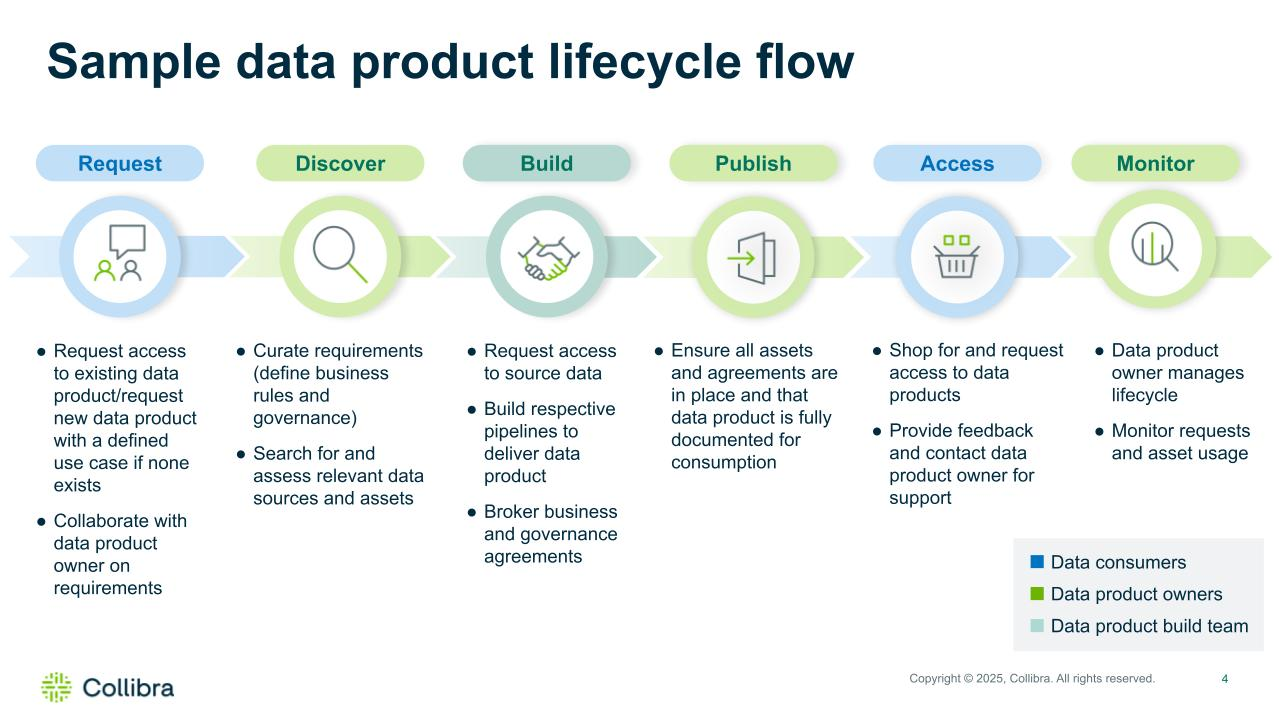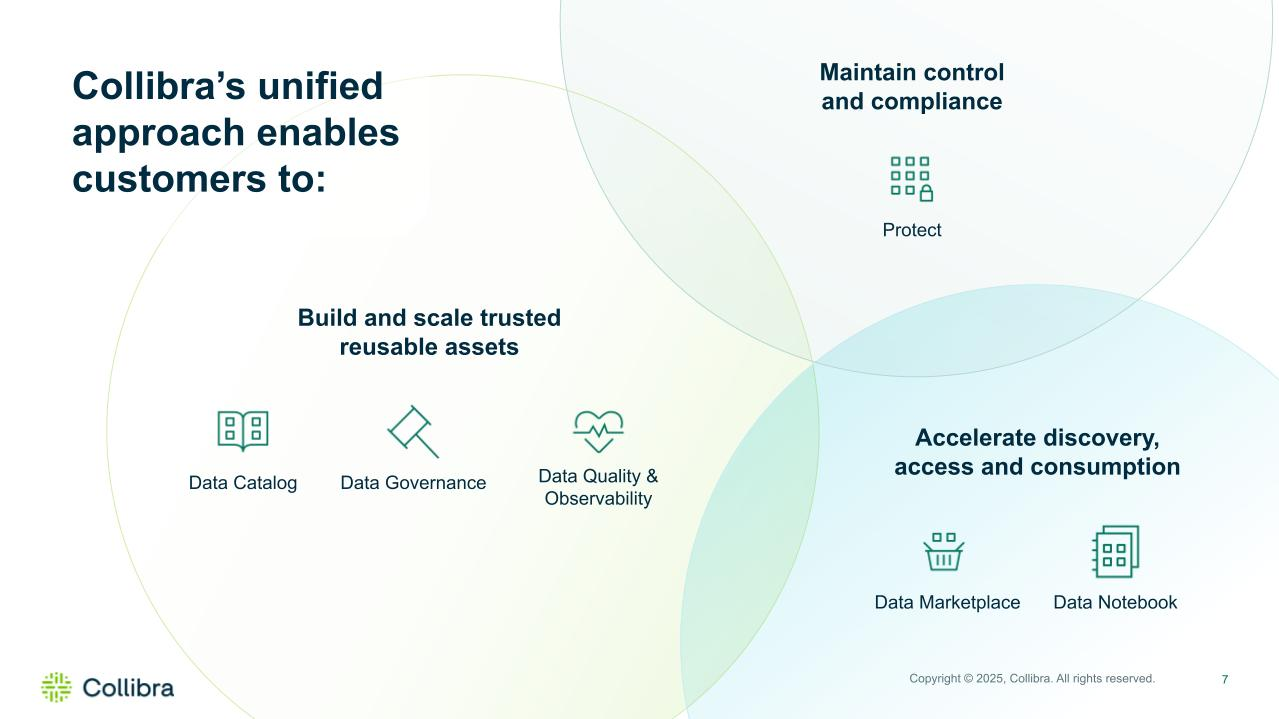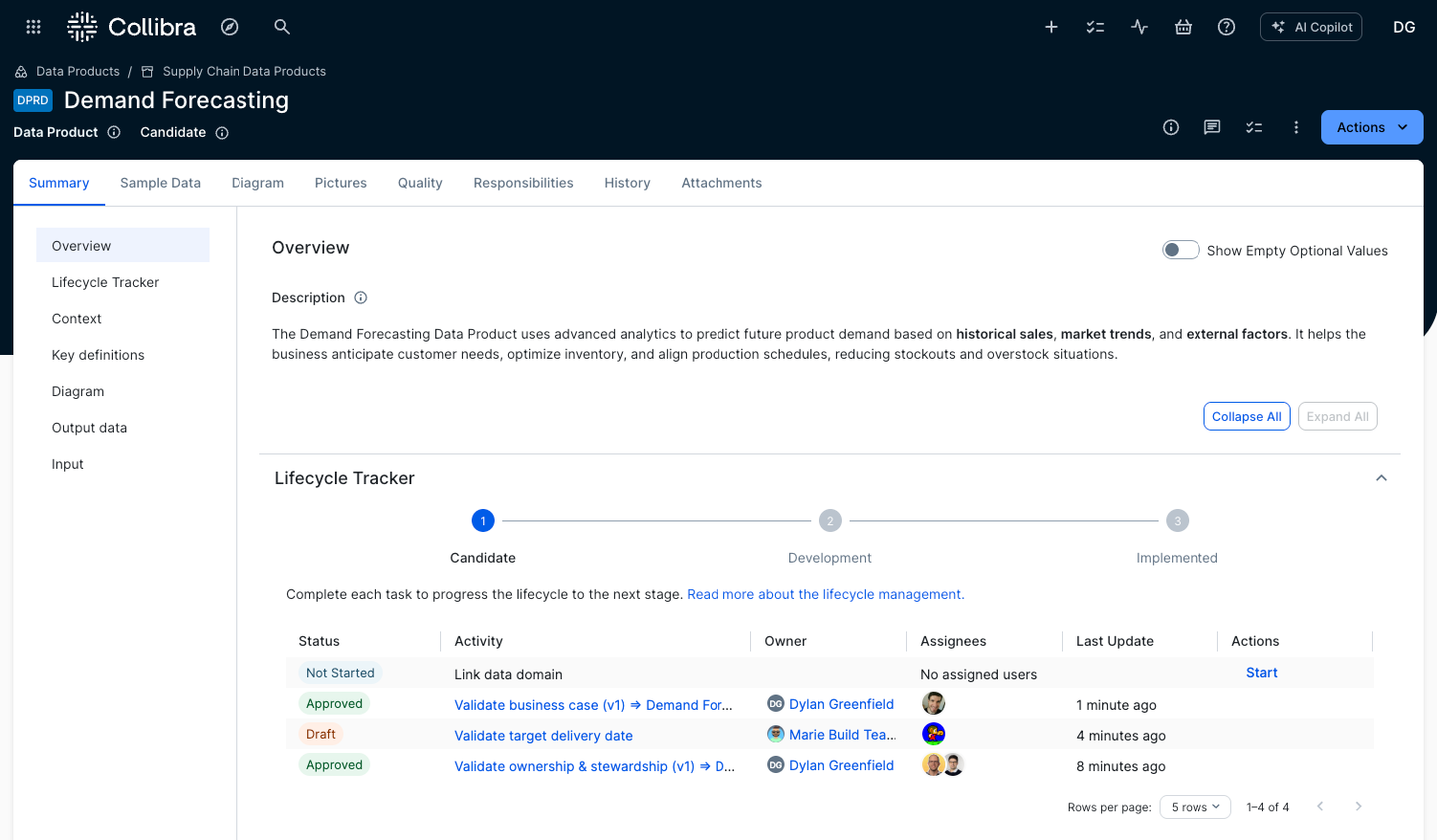Getting started with data products: A practical introduction

Data is clearly a strategic asset, but many teams still struggle to turn it into something useful, let alone trusted or AI-ready.
A significant 44% of data professionals report not having access to the right data needed for their jobs, while 41% of executives consider their data to be "substandard". 1, 2 Furthermore, a third of executives (33%) identify timely data delivery as a top priority for data operations improvement. 2 These challenges are only set to intensify as data complexity continues to grow exponentially.
To make data more accessible, reusable and valuable across your organization, treat data as a product, not just an asset. This approach helps organizations better understand the value and utility of their data, fostering stronger connections between data producers and consumers through internal data marketplaces.
The benefits of data products
A data product is a reusable and consumable data artifact combined with its business purpose and meaning. It also provides clear information on how to access the data. This approach to combining data, business context and meaning, and access instructions offers several key benefits:
- Drive strategic alignment: Data products deliver data assets with a defined purpose, owner and measurable impact, making it easy to ensure alignment with organizational goals and for others to understand their value.
- Strengthen AI-readiness: Data products are essential for advancing AI capabilities by providing high-quality, trusted data with built-in semantic and business context to power AI models and enable autonomous AI systems. They serve as reusable building blocks for AI use cases, offering clear, repeatable inputs that can be rigorously monitored and observed, with data contracts ensuring quality.
- Enable faster insights: Data products empower users with quick, governed self-service access to trusted data, which significantly accelerates data-driven decision-making and promotes data democratization. This enhances self-service capabilities, fosters innovation and improves data literacy.
- Ensure accountability and compliance: Implementing data products involves assigning clear ownership, enforcing governance policies and maintaining transparency to meet regulatory compliance requirements. This framework ensures the appropriate stakeholders are accountable for data product ownership and compliance.
- Boost productivity and reduce costs: Data products enhance efficiency and reduce costs by minimizing data duplication, breaking down data silos, reducing reliance on IT and promoting asset reuse. Their well-defined and reusable structure also simplifies the creation of new offerings, which further improves productivity and reduces expenditures. Data products have been shown to deliver data-intensive applications 90% faster and with a 30% reduction in costs, while also lowering risk and data governance burden. 3

Data products are key for scaling trust, insights and innovation across your organization. By treating data as a product, you can align your organization’s data strategy with your business goals—and make your data AI-ready so it can be used to train a model, launch a campaign or report to regulators.
Laying the foundation
But how do you get started?
Successfully deploying data products requires a structured approach involving the right people, well-defined processes and essential tools.
People: defining roles and responsibilities
Let’s start with identifying the right people and responsibilities – these can be broken down into two key layers of stakeholders:
- Sample roles at the overall data product initiative level include:
- Executive sponsor: Provides overarching support and momentum for the data product journey
- Program manager: Manages the initiative from end-to-end
- Data catalog team: A centralized team responsible for ingesting metadata into a data catalog tool that enables the creation, management and discovery of data products
- At the data product-level, typical roles include:
- Data product owner: Curates and refines data product requirements, defines business value, searches for relevant assets and manages the data product lifecycle
- Technical steward/data product build team: Design, assemble and operationalize the underlying data structures, transformations and integrations needed to deliver a functional and reliable data product
- Business steward/SME: Provides business context, collaborates on processes and ensures compliance with policies and standards
These roles ensure your data products are grounded in business context, technically sound and actually adopted across your organization.
Processes: Establishing a scalable framework
Once you have the right people, you need to establish a structured and user-focused framework for building and managing valuable data products. One that we recommend consists of three main components:
- Data products governance model: Define the blueprint for managing data products across your organization. This includes best practices, asset management, assigned roles and a clear lifecycle for every data product.

- Governed data product processes: Implement standardized workflows for developing, certifying and publishing data products. These ensure consistency, compliance and alignment with your governance model.
- User-centric design: Put your users first by designing intuitive, role-based experiences. Map out the end-to-end user journey – from data product request to consumption – so that adoption is seamless and sustained.
Together, these components empower organizations to scale data products with clarity, consistency and impact. Next, let’s explore how the right tools can bring this framework to life.
Tools: Equipping teams for success
To effectively implement these processes and the overall framework, certain critical capabilities are essential:
- Flexible data product framework: An adaptable out-of-the-box (OOTB) model that provides valuable guidance, allowing for the ability to extend based on an organization's specific needs.
- Data marketplace: A centralized portal that simplifies the discovery and request process for data products, acting as the primary interface for consumers.
- Collaboration and feedback mechanisms: Enables users to rate, review, comment, and provide feedback on data products, fostering continuous improvement.
- Data access considerations: Includes robust data sharing agreements, access management protocols, and flexible request fulfillment to ensure timely and appropriate access to data.
- Usage tracking and reporting: Provides useful insights into data product adoption and value, allowing organizations to measure the impact on the business.
- Data contracts: Clear agreements on data availability, update frequency, and support, crucial for scaling and ensuring data quality.
With these critical capabilities in place, organizations are well-equipped to build and scale effective data products.
How Collibra empowers your data product journey
Collibra delivers a complete platform for data and AI governance, giving teams the visibility, control and confidence to turn data into a trusted asset.

For organizations building a data product strategy, Collibra’s unified approach supports three critical areas:
- Building and scaling trusted, reusable data assets: An extendable out-of-the-box framework and flexible workflows provide guidance and bring consistency to how data products are defined and managed across teams. Integrated data quality and observability and data contracts help ensure data products are reliable and fit for use, while glossaries, KPIs and lineage add the business context and traceability needed to drive understanding and trust. A federated model allows domain teams to manage their products independently while adhering to global governance standards.
- Maintaining control and compliance compliance: Collibra supports consistent, compliant data use through policy management, data sharing agreements and automated classification and masking that protect sensitive information – all helping teams align with both internal and external regulatory requirements across the organization.
- Accelerating discovery, access and consumption: A centralized data marketplace, integrated access workflows and built-in feedback mechanisms make it easier for users to find, request and engage with data products. Collaborative querying and documentation capabilities support teamwork and knowledge sharing, while usage analytics offer valuable insights into adoption and performance.
With these integrated capabilities, Collibra enables teams to deliver governed, high-quality data products that are easy to discover, understand and use – supporting confident decisions and readiness for AI at scale.
New innovations powering data products at Collibra
Collibra continues to enhance the data product experience with new innovations that simplify deployment and lifecycle management, as highlighted in our recent Product Premiere:
- The acquisition of Raito redefines data access governance for the AI era, providing a unified command center for confidently using data and AI. By unifying Collibra’s semantic graph with Raito’s security graph, organizations can define access policies once and enforce them across various multi-cloud platforms, enhancing visibility, traceability and control while providing faster, frictionless and compliant access to data products.
- A lifecycle progress tracker for data products accelerates the management and publishing of data products, providing clear visibility into each stage, with adaptable phases designed to align with your organization’s requirements.
- Visual widgets on data product asset pages enhance data product consumption and engagement through intuitive displays, such as relation diagrams to increase visibility of dependencies and output viewers for clear inspection and verification of output data.
- Data usage capabilities allow you to identify and analyze how often Snowflake data is queried, track total users and queries and assess data relevance with a "popularity score," driving prioritization efforts.
- Data Quality & Observability (DQ&O) unified with the Collibra Platform accelerates enforcement of governance by automating technical rule creation, simplifies collaboration through unified interfaces and workflows, and streamlines deployment and maintenance with centralized connections and user management.
- Collibra AI Copilot optimizes asset discoverability using generative AI, allowing data consumers to more easily discover data assets (including data products), look up business glossary definitions and search Collibra product documentation using simple, natural language.

Build trusted data products using Collibra
Instead of serving every user every piece of data, Collibra enables you to curate reusable data products and make them available through a governed, self-service marketplace – bridging the gap between data producers and consumers.
Leading organizations like Toyota Motor Europe use Collibra to scale access to trusted data products across their data mesh. Likewise, SAP relies on Collibra to register, govern, and secure their data products at enterprise scale.
Now you can accelerate innovation and growth by giving teams easy access to high-quality, compliant data products – each with clear ownership, purpose and usage guidance. This helps your organization move faster, stay aligned and scale data and AI initiatives with confidence.
Want to learn more?
- Watch our on-demand webinar to learn what it takes to operationalize data products: Getting started with data products: The people, processes and tools you need
- T ake a tour of the Collibra Platform
- Schedule a Collibra demo to accelerate your Collibra journey
In this post:
- The benefits of data products
- Laying the foundation
- People: defining roles and responsibilities
- Processes: Establishing a scalable framework
- Tools: Equipping teams for success
- How Collibra empowers your data product journey
- New innovations powering data products at Collibra
- Build trusted data products using Collibra
- Want to learn more?
Related articles

Data GovernanceApril 17, 2025
Strengthening data reliability at WGU through smarter governance

PartnerJanuary 26, 2024
Collibra is proud to be part of the Snowflake Horizon Partner Ecosystem

Data CatalogMay 22, 2023
Facing your data challenge with a data catalog

Data CatalogAugust 25, 2025
How to build a data catalog: Step-by-step
Keep up with the latest from Collibra
I would like to get updates about the latest Collibra content, events and more.
Thanks for signing up
You'll begin receiving educational materials and invitations to network with our community soon.


